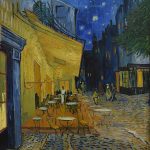When you think of Vincent van Gogh, images of swirling night skies, vibrant sunflowers, and starry cafes come to mind. His tumultuous life is almost as famous as his art. Among the many chapters of his dramatic existence, one story stands out but often remains overshadowed by his more publicized struggles. This is the poignant and ill-fated love story of Vincent van Gogh and Margot Begemann, a tale that reflects the intense yet fleeting nature of van Gogh’s relationships and his perpetual search for stability and affection.
The Backdrop: Nuenen, 1884
In 1884, Vincent van Gogh was living in Nuenen, a small village in the Netherlands. He had returned home to live with his parents after a string of unsuccessful ventures, including stints as an art dealer, teacher, and preacher. His father, a pastor, had recently been appointed to the village church, and Vincent found solace in the quiet countryside, focusing on his painting. It was here that he began to develop his distinct style, deeply influenced by the peasants and rural landscapes surrounding him.
Margot Begemann: The Woman Next Door
Enter Margot Begemann, a neighbor and fellow villager. Margot was ten years Vincent’s senior, part of a well-to-do family that lived nearby. Unlike many women of her time, Margot was highly educated and cultured, a perfect match for the intellectually inclined Vincent. Their paths crossed frequently, given their proximity and shared social circles.
Margot and Vincent’s relationship blossomed over shared walks and conversations about art and life. For Vincent, who often felt misunderstood and isolated, Margot’s companionship was a breath of fresh air. She appreciated his art and intellect, offering the emotional support he so desperately needed. In Margot, Vincent found a kindred spirit, someone who understood his dreams and struggles.
A Love Blossoms
Their relationship quickly deepened. Vincent, known for his intensity in both art and life, fell passionately for Margot. He wrote to his brother Theo, his closest confidant, about her, expressing his hopes and fears. Margot, too, was smitten, finding in Vincent a creative and kindred soul who stirred her emotions in ways she hadn’t experienced before.
However, their love was not meant to be a simple, happy affair. Both Vincent and Margot were troubled individuals. Vincent’s mental health issues were already beginning to surface, manifesting in his erratic behavior and bouts of depression. Margot, on the other hand, was dealing with her own emotional struggles, exacerbated by a strict family environment and societal expectations.
The Societal Storm
The villagers of Nuenen and their families did not view their relationship kindly. Margot’s family, in particular, was vehemently opposed to the match. They saw Vincent as a penniless artist with no stable future, an unsuitable match for Margot. Vincent’s family, while less outspoken, also harbored doubts about the relationship, given Vincent’s ongoing struggles and lack of prospects.
The societal pressures began to weigh heavily on Margot. Torn between her love for Vincent and her family’s disapproval, she found herself in an increasingly precarious emotional state. The strain of this internal conflict, coupled with her existing emotional vulnerabilities, pushed her to a breaking point.
The Tragic Turn
In the summer of 1884, the relationship took a tragic turn. Margot, unable to cope with the mounting pressure and her own emotional turmoil, attempted suicide by ingesting poison. She survived, thanks to prompt medical intervention, but the incident left both her and Vincent deeply scarred. Vincent, already struggling with his mental health, was devastated. He blamed himself for Margot’s suffering, plunging further into despair.
Margot’s family, understandably protective and upset, forbade her from seeing Vincent again. The relationship was effectively over, leaving both parties heartbroken and adrift. For Vincent, this was yet another blow in a life marked by rejection and unfulfilled desires.
The Aftermath
The aftermath of their ill-fated love left a lasting impact on both Vincent and Margot. Vincent channeled his emotional turmoil into his art, which became increasingly dark and introspective. His paintings from this period, such as “The Potato Eaters,” reflect his deepening sense of isolation and despair. Margot, on the other hand, retreated from the public eye, her life forever altered by the traumatic events.
Vincent’s subsequent years were marked by a series of moves and a continuous struggle with his mental health. He found temporary solace in his work, producing some of his most famous pieces during this period. Yet, the shadow of his past relationship with Margot lingered, influencing his art and his perception of love and companionship.
A Fleeting Glimpse of Happiness
Despite the brevity and tragic end of their relationship, Margot’s influence on Vincent was profound. She was one of the few people who truly understood him, offering a glimpse of the happiness and stability he yearned for but could never fully grasp. Their ill-fated romance highlighted Vincent’s desperate need for connection and the relentless obstacles he faced in achieving it.
Legacy of a Tragic Love
Vincent van Gogh’s life was a series of emotional highs and lows, with Margot Begemann representing both a high and a devastating low. Their story is a testament to the complexities of love and mental health, illustrating how external pressures and internal struggles can intertwine to shape the course of our lives.
While Margot may not be as well-known as other figures in Vincent’s life, her impact on him was undeniable. Their ill-fated love story adds a layer of depth to our understanding of van Gogh, revealing the human vulnerabilities behind the artistic genius. As we gaze at Vincent’s masterpieces, we are reminded of the personal battles he fought and the poignant, often painful experiences that fueled his creative spirit.
In the end, Vincent and Margot’s story is one of love, loss, and the enduring search for understanding and connection. It serves as a poignant reminder that behind every great artist lies a complex web of relationships and emotions that shape their work and legacy.



